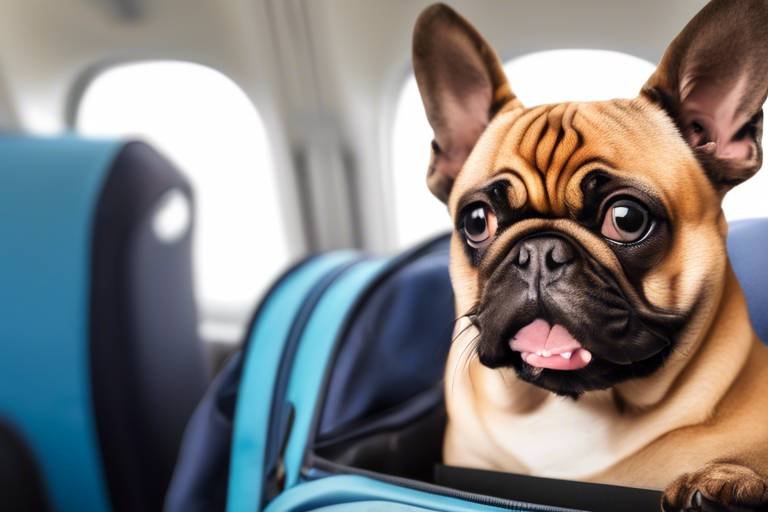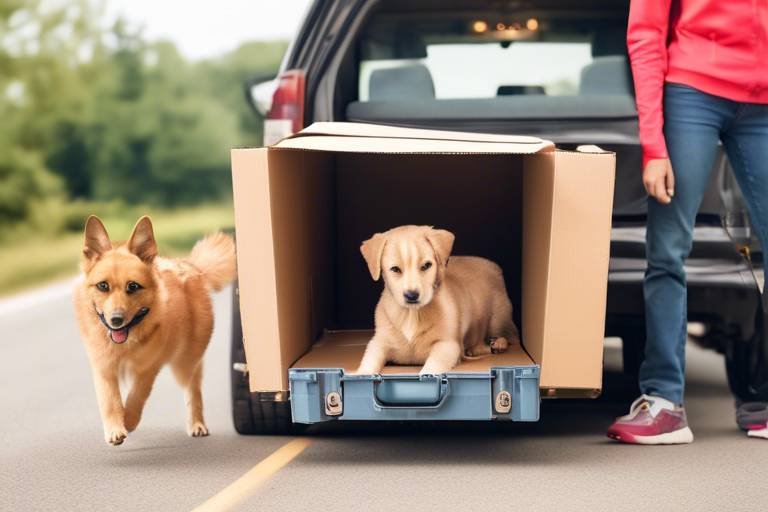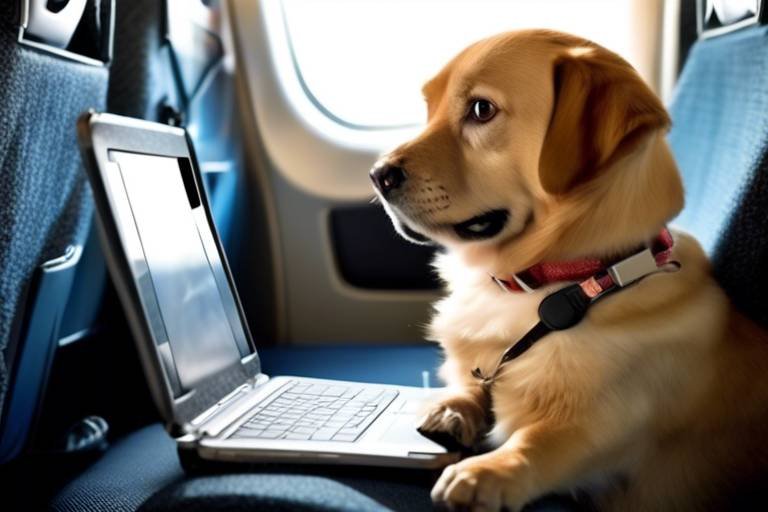Traveling with Pets - What to Do in Case of an Emergency
Traveling with your furry companions can be one of life's greatest joys, but it comes with its own set of challenges, especially when it comes to emergencies. Imagine you're on a beautiful road trip, the wind is in your hair, and your pet is happily wagging its tail in the backseat. Suddenly, a situation arises that requires immediate attention. What do you do? This article provides essential tips and guidelines for pet owners traveling with their furry friends, focusing on how to handle emergencies effectively while on the road.
Preparation is key when traveling with pets. Before you even think about hitting the road, there are several essential items you should pack to ensure your pet's safety. Think of it as packing a mini survival kit for your beloved companion. This kit should include:
- First Aid Kit: Include bandages, antiseptic wipes, and any medications your pet may need.
- Emergency Contact Information: Have a list of your veterinarian's contact details and emergency clinics along your route.
- Identification: Ensure your pet has a collar with an ID tag and consider a microchip for added security.
- Comfort Items: Bring along your pet's favorite blanket or toy to help soothe them in stressful situations.
Taking these steps can significantly reduce the stress of unexpected situations. Just like you wouldn't leave home without your phone charger, don't forget these essentials for your pet!
Knowing where to find veterinary services along your route is crucial. Imagine you're in a small town and your pet suddenly falls ill. Panic can set in, but if you’ve done your homework, you can swiftly locate nearby animal hospitals and clinics. A quick online search or a call to your regular vet can help you identify emergency services along your travel path.
Utilizing mobile apps and websites can help you find emergency services quickly. There are several apps designed specifically for pet owners that allow you to search for nearby vets, read reviews, and even get directions. These tools can be lifesavers in critical moments. For instance, apps like Pet First Aid and VetFinder can guide you to the nearest facilities in no time.
Creating a list of emergency contacts, including veterinarians and pet-friendly accommodations, can save time during a crisis. Keep this list handy—perhaps in your glove compartment or on your phone. This way, when the unexpected happens, you won’t waste precious minutes trying to remember who to call.
Knowing the locations of local animal shelters can be beneficial. These shelters often provide temporary care for pets in emergencies. If you find yourself in a bind, they might be able to assist you while you figure out your next steps. It’s like having a safety net; you never know when you might need it!
Basic first aid knowledge can be lifesaving. Just like you would know how to treat a scrape or a burn on yourself, you should be prepared to handle minor injuries your pet might encounter. Familiarize yourself with essential first aid techniques, such as:
- How to perform CPR on pets
- How to bandage a wound
- Recognizing signs of shock
Equipping yourself with this knowledge can make a significant difference in your pet's well-being during emergencies.
Different situations require different responses. Whether it’s dealing with injuries, managing illness, or finding a lost pet, knowing how to react can save your pet's life. For instance, if your pet gets injured, the first step is to assess the situation calmly. Look for bleeding, swelling, or signs of pain. If it’s a minor injury, you might be able to treat it with the first aid kit you packed. However, if it seems serious, don’t hesitate to seek professional help.
Injuries can happen unexpectedly, whether from jumping out of the car or during a playful romp in the park. Always carry a basic first aid kit and know how to use it. Remember, if you’re uncertain about the severity of an injury, it’s always best to consult a veterinarian.
Travel can sometimes trigger health issues in pets, such as motion sickness or anxiety. Recognizing the signs of illness—like excessive drooling, vomiting, or lethargy—can help you take action quickly. If your pet shows any of these symptoms, pull over safely and assess the situation. Sometimes a little fresh air and a break can do wonders, but if symptoms persist, don’t hesitate to seek veterinary assistance.
Q: What should I include in a pet emergency kit?
A: Your kit should include a first aid kit, medications, emergency contact information, food and water, and comfort items like toys or blankets.
Q: How can I find a vet in an unfamiliar area?
A: Use mobile apps designed for pet owners, or search online for veterinary services in the area you’re traveling through.
Q: What should I do if my pet gets lost while traveling?
A: Stay calm, retrace your steps, and ask locals for help. Utilize social media or local lost pet groups to spread the word quickly.

Preparing for Emergencies
When it comes to traveling with your furry companions, preparation is your best friend. Imagine hitting the open road, the wind in your hair, and your pet happily wagging their tail beside you. But what happens if an unexpected twist arises? To ensure that your adventure remains a joyous one, it’s essential to be ready for any emergencies that may come your way. Start by packing a comprehensive pet emergency kit. This kit should include items like a first aid kit specifically designed for pets, any medications your pet might need, and a copy of their medical records. Don’t forget to bring along your pet’s favorite toys or blankets to provide comfort in unfamiliar surroundings.
Additionally, it’s wise to have a travel checklist that includes all necessary supplies. Here’s a quick rundown of what to include:
- Water and food bowls
- High-quality pet food
- Leash and harness
- Waste bags for cleanup
- Identification tags with your contact information
Before you embark on your journey, take the time to familiarize yourself with the route you’ll be taking. Knowing where to stop for breaks not only benefits you but also gives your pet a chance to stretch their legs. It’s also a good idea to research pet-friendly accommodations along the way. This way, if an emergency arises, you’ll know exactly where to go for help.
In addition to physical preparations, don’t overlook the importance of mental readiness. Have a plan in place for various scenarios. For instance, what would you do if your pet gets lost? Or if they have an allergic reaction to something they encountered on the road? Discuss these scenarios with your travel companions and ensure everyone knows their role in an emergency situation. This proactive approach can significantly reduce panic and confusion when time is of the essence.
Finally, consider investing in a pet-friendly GPS tracker. These devices can be a lifesaver, allowing you to locate your pet quickly if they wander off. With all these preparations in place, you can focus on enjoying the journey ahead, knowing that you’re ready for anything that may come your way.
Q: What should I include in my pet emergency kit?
A: Your pet emergency kit should include a first aid kit, medications, medical records, food, water, bowls, leash, harness, and waste bags.
Q: How can I find veterinary services while traveling?
A: Research veterinary clinics along your route before you leave, and consider using mobile apps that can help locate services quickly.
Q: What should I do if my pet gets lost during our trip?
A: Stay calm and retrace your steps. Use a GPS tracker if available, and notify local shelters and veterinary clinics.

Identifying Emergency Services
When you're on the road with your furry companion, knowing where to find emergency services is not just a good idea—it's essential. Imagine you're cruising down the highway, the windows down, and your pup is enjoying the breeze, when suddenly, a mishap occurs. Whether it's a minor injury or a sudden illness, having a plan in place can make all the difference. So, how do you identify emergency services along your route? Let's dive into some practical steps you can take to ensure that help is always within reach.
First off, it’s wise to do a bit of research before your trip. Many pet owners overlook this crucial step, thinking that they can wing it. But trust me, a little preparation goes a long way. Start by searching for veterinary clinics and animal hospitals along your planned route. You can use online maps or apps specifically designed for pet owners. Websites like VetFinder or PetMD can help you locate nearby veterinary services, often complete with reviews and ratings. This way, you can choose a facility that you feel comfortable with.
Another smart move is to keep a list of emergency contacts handy. This list should include your regular veterinarian's phone number, emergency animal hospitals, and even pet-friendly accommodations that can assist in case of an emergency. You can create a simple table to keep this information organized:
| Type of Contact | Name | Phone Number | Address |
|---|---|---|---|
| Regular Vet | Your Vet's Name | (123) 456-7890 | 123 Pet Lane, City, State |
| Emergency Vet | Emergency Vet Clinic | (987) 654-3210 | 456 Animal Ave, City, State |
| Pet-Friendly Hotel | Pet Stay Inn | (555) 123-4567 | 789 Travel Rd, City, State |
Now, let’s talk about technology. In today’s digital age, there’s no shortage of apps designed to help pet owners. For instance, apps like Pet First Aid can guide you through emergency situations, while others like BringFido can help you find pet-friendly places and emergency services nearby. With just a few taps on your smartphone, you can access a wealth of information that can save precious time in a crisis.
Don’t forget about local animal shelters! Knowing the locations of these shelters can be a lifesaver. They not only provide temporary care for pets but often have resources available for emergencies. If you find yourself in a bind, shelters can help guide you to the nearest veterinary services or offer assistance in caring for your pet until you can get to a vet. It’s a good idea to check the websites of shelters along your route or call ahead to gather information about their services.
In conclusion, identifying emergency services while traveling with your pet is all about preparation and utilizing available resources. By doing your homework, keeping a handy contact list, and leveraging technology, you can ensure that you're ready for anything that comes your way. Remember, a little effort in planning can lead to a safer, more enjoyable journey for both you and your furry friend.
Using Technology
In today's fast-paced world, technology is a pet owner's best friend, especially when it comes to handling emergencies while traveling. Imagine you're on a road trip with your furry companion, and suddenly, they seem unwell or get injured. Panic sets in, but with the right tech tools at your fingertips, you can quickly find the help you need. Mobile apps and websites designed for pet owners can be lifesavers in these situations.
First off, there are numerous mobile applications specifically tailored for pet emergencies. Apps like Pawtrack and Pet First Aid provide instant access to first aid tips, emergency contacts, and even a directory of nearby veterinary services. These apps often include features like GPS tracking, which can help you pinpoint the closest animal hospital in a matter of seconds. Imagine how reassuring it is to have all this information right in your pocket!
Moreover, utilizing social media platforms can be incredibly beneficial. Many local veterinary clinics and animal hospitals have active social media profiles where they share important updates, emergency services, and even community events. By following these accounts, you can stay informed about the nearest facilities that can provide immediate assistance to your pet. Additionally, platforms like Facebook and Nextdoor can connect you with local pet owners who may have recommendations or insights on emergency services in the area.
Another tech-savvy way to prepare is by maintaining a digital emergency contact list. You can create a simple document on your phone or cloud storage that includes:
- Your veterinarian's contact information
- Nearby animal hospitals along your route
- Pet-friendly accommodations that are aware of your pet's needs
- Local animal shelters for unexpected situations
This list can be easily updated and accessed anytime you need it, ensuring you have vital information at your fingertips. Just think of it as your pet's personal emergency handbook!
Lastly, don't underestimate the power of online reviews. Websites like Yelp and Google Reviews allow you to assess the quality of veterinary services based on real customer experiences. Reading through reviews can help you choose a reputable clinic when you're in a bind, ensuring your furry friend receives the best care possible. In essence, technology not only simplifies our lives but also enhances our ability to care for our pets, especially in emergencies.
Emergency Contact List
Creating an is one of the most proactive steps a pet owner can take before embarking on a journey. Imagine this: you're on a beautiful road trip with your furry friend, and suddenly, an unexpected situation arises. Having a well-organized list of contacts can be a lifesaver in such moments. This list should include not only your regular veterinarian's contact information but also details for emergency veterinary clinics along your travel route.
When compiling this list, consider including:
- Your Primary Veterinarian: Include their phone number and address, as they know your pet's medical history best.
- Emergency Veterinary Clinics: Research and list a few clinics in the areas you will be traveling through. Make sure to note their hours of operation, as some may only be open at night or during weekends.
- Pet-Friendly Accommodations: In case of an emergency, knowing where to stay can relieve a lot of stress. List hotels or motels that are pet-friendly and their contact details.
- Local Animal Shelters: Having the contact information for nearby shelters can be beneficial if you need temporary care for your pet.
Don't forget to keep this list accessible! You can store it in your phone or print a copy to keep in your glove compartment. This way, in a moment of panic, you won’t be frantically searching for numbers or addresses. Also, consider sharing this list with a trusted friend or family member who can assist you if needed.
Regularly update this list to reflect any changes in your pet's health or your travel plans. It’s a simple task that can make a world of difference when every second counts. Remember, being prepared is half the battle, and with this list at your fingertips, you’ll feel more confident and ready to tackle any emergency that may arise while traveling with your beloved pet.
Local Animal Shelters
When you're on the road with your beloved pet, knowing the locations of can be a game-changer. Shelters are not just places to adopt pets; they can also serve as safe havens in emergencies. Imagine your furry friend getting lost or injured while you're miles away from home—having a nearby shelter can provide peace of mind. Many shelters offer temporary care, which can be a lifesaver if you find yourself in a pinch.
Before you embark on your journey, it's wise to do some research on the animal shelters along your route. You can find contact information and addresses through a quick online search or by using mobile apps that specialize in pet care. Some shelters even have websites that provide details about their facilities, services, and hours of operation, so you know what to expect when you arrive. This is particularly helpful if you need to seek shelter for your pet due to unforeseen circumstances, such as bad weather or a sudden illness.
Additionally, many shelters are equipped with resources and staff who can assist you in various situations. They often have veterinarians on-site or can refer you to nearby clinics. In some cases, shelters might even offer boarding services if you need to take your pet somewhere for a short period. This kind of support can alleviate the stress of an emergency situation, allowing you to focus on your pet's well-being.
It's also worth noting that some animal shelters have partnerships with local veterinarians and pet services, which can be beneficial in case of an emergency. These collaborations can provide you with a network of support, ensuring that your pet receives the care they need without delay. So, before you hit the road, take a moment to jot down the names and contact information of local shelters along your route. You never know when this knowledge might come in handy!
In summary, knowing the locations of local animal shelters can provide a safety net for you and your pet while traveling. Whether it's for temporary care, medical assistance, or simply a safe place to regroup, these shelters can make all the difference in your travel experience.
Emergency First Aid for Pets
When you're on the road with your furry companion, the last thing you want is for something to go wrong. However, just like any other adventure, traveling can come with its share of bumps—literally and figuratively. That's why having a basic understanding of is crucial. Imagine your dog spraining a paw while hiking or your cat experiencing a sudden allergic reaction; knowing what to do can make all the difference.
First and foremost, it's essential to have a well-stocked pet first aid kit handy. This kit should include items such as antiseptic wipes, gauze, adhesive tape, scissors, tweezers, and any medications your pet may need. You can easily purchase a pre-made kit or create your own. Just remember, it’s like having an insurance policy for your pet—better to have it and not need it than to need it and not have it!
In addition to your first aid kit, familiarize yourself with some basic first aid techniques. For instance, if your pet gets a cut, you should first clean the wound with saline solution or clean water, then apply an antiseptic. If the bleeding is severe, apply direct pressure with a clean cloth or gauze until the bleeding stops. In cases of fractures or sprains, it’s best to keep your pet calm and still until you can get them to a veterinarian. Remember, staying calm yourself is half the battle; pets can sense your anxiety, which may exacerbate their distress.
Another important aspect of emergency first aid is understanding how to perform CPR on pets. While it may sound daunting, knowing the basics can be lifesaving. If your pet is unresponsive and not breathing, you can perform CPR by following these steps:
1. Check for breathing. If there’s none, proceed. 2. Place your pet on their side. 3. For dogs, give 30 chest compressions followed by 2 rescue breaths. For cats, use one hand to compress the chest and give 2 rescue breaths. 4. Repeat until help arrives or your pet starts breathing.
It's also beneficial to know how to handle specific emergencies, like choking. If your pet is choking, try to determine if they are still breathing. If they are not, you might need to perform the Heimlich maneuver for pets. For small dogs, hold them upside down and give a few firm pats on the back. For larger dogs, place your hands just below their rib cage and thrust inward and slightly upward.
Lastly, don't underestimate the importance of keeping a calm demeanor during emergencies. Your pet looks to you for reassurance, and your ability to remain composed can help them feel more secure. Always remember that the goal is to stabilize your pet until you can get them to a veterinarian.
In summary, being prepared with a first aid kit, knowing basic techniques, and maintaining a calm attitude are vital components of handling emergencies while traveling with your pet. With these skills in your back pocket, you can embark on your adventures with confidence, knowing that you’re equipped to handle whatever comes your way!
- What should I include in my pet first aid kit?
Your kit should contain antiseptic wipes, gauze, adhesive tape, scissors, tweezers, and any necessary medications. Don't forget a pet first aid manual!
- How do I know if my pet needs CPR?
If your pet is unresponsive and not breathing, they may need CPR. Always check for breathing first.
- Can I perform first aid on my pet at home?
Yes, many first aid techniques can be performed at home, but it's crucial to consult a veterinarian as soon as possible for serious injuries.
- What should I do if my pet is choking?
Determine if they are still breathing. If not, perform the Heimlich maneuver appropriate for their size.

Handling Specific Emergencies
When you're on the road with your beloved pet, the last thing you want to think about is an emergency. However, just like any good scout, it's best to be prepared! Emergencies can come in various forms, from minor injuries to sudden illnesses or even your pet getting lost. Understanding how to handle these situations can make a world of difference, not just for your peace of mind but also for the safety of your furry friend.
First up, let's talk about injuries. Imagine you're at a beautiful park, and your dog, full of energy, takes off chasing a squirrel. In the excitement, they trip and scrape their paw. While it might seem like a small issue, it's essential to assess the injury right away. Always carry a pet first aid kit with you, which should include items like antiseptic wipes, bandages, and tweezers. Knowing how to clean and bandage a wound can prevent infections and keep your pet comfortable until you can get them to a vet. If the injury looks severe, don't hesitate to seek veterinary assistance. Remember, your pet can't tell you where it hurts, so being observant is crucial!
Next, let's discuss how to manage illnesses. Travel can be stressful for pets, and sometimes that stress manifests as vomiting or diarrhea. If you notice your pet is acting differently—maybe they're lethargic or refusing to eat—these could be signs of an upset stomach or more serious health issues. Always keep your veterinarian's number handy, and don't hesitate to call them for advice. They might suggest a few remedies or recommend that you visit a local vet. Recognizing the signs of distress early can help you take action before things escalate.
Another common emergency is losing your pet. This can be a heart-stopping moment for any pet owner. To prevent this, make sure your pet is microchipped and wearing a collar with an ID tag that has your contact information. If your pet goes missing, act quickly! Start by searching the immediate area, calling their name, and checking places they might hide. You can also post on social media or local community boards. Many neighborhoods have dedicated lost-and-found pet groups that can help spread the word quickly. The faster you act, the better the chances of a safe reunion!
In addition to these specific emergencies, it's essential to stay calm and collected. Your pet can sense your stress, and if you're panicking, it might only add to their anxiety. Take a deep breath, assess the situation, and remember that being prepared is half the battle. After all, traveling with pets should be an adventure filled with joy rather than fear. Equip yourself with knowledge, keep your emergency contacts handy, and most importantly, enjoy the journey!
- What should I include in a pet first aid kit? A basic kit should include antiseptic wipes, gauze, adhesive tape, tweezers, and any medications your pet may need.
- How can I find a vet while traveling? Use mobile apps or websites that list veterinary services along your route. It's also helpful to have a list of emergency contacts ready.
- What should I do if my pet gets lost? Act quickly by searching the area, calling their name, and posting on social media or local community boards.
Dealing with Injuries
When you're on the road with your furry companion, the last thing you want is for them to get injured. Yet, accidents can happen in the blink of an eye, much like a sudden rainstorm on a sunny day. Being prepared to deal with injuries is crucial for every pet owner. First and foremost, it’s essential to remain calm. Your pet can sense your emotions, and your anxiety can heighten their stress. Take a deep breath and assess the situation.
If your pet has sustained a minor injury, such as a scrape or a cut, it’s important to clean the wound properly. Use clean water to rinse the area, and if you have a pet-safe antiseptic, apply it gently. Bandaging may be necessary to prevent further injury or infection. However, ensure that the bandage isn’t too tight, as this could cut off circulation. You might want to keep an eye on the injury for a few days, watching for signs of infection, such as swelling or discharge.
For more serious injuries, like deep cuts or fractures, immediate veterinary attention is essential. If you’re in a remote area, it’s wise to have a plan in place. This could include knowing the location of the nearest veterinary clinic or animal hospital along your route. In such cases, you may need to stabilize your pet for transport. Here are a few steps to follow:
- Keep your pet calm: Speak softly and reassure them.
- Control bleeding: Apply pressure with a clean cloth or bandage.
- Immobilize fractures: Use a makeshift splint to keep the injured area stable.
- Transport safely: Use a pet carrier or a secure space in your vehicle to prevent further injury.
It’s also a good idea to have an emergency first aid kit specifically for your pet. This kit can include items like bandages, antiseptic wipes, gauze, and even a digital thermometer for pets. You can create a simple table to keep track of what to include in your kit:
| Item | Purpose |
|---|---|
| Bandages | To cover wounds and prevent infection. |
| Antiseptic wipes | To clean wounds safely. |
| Gauze | For absorbing blood and covering larger wounds. |
| Digital thermometer | To check for fever in pets. |
Remember, prevention is always better than cure. Try to anticipate potential hazards while traveling, whether it’s keeping them away from busy roads or ensuring they’re secure in the vehicle. Just like you wouldn’t drive without a seatbelt, don’t travel with your pet without taking the necessary precautions. In case of an emergency, having a plan can make all the difference.
Q: What should I do if my pet gets injured while traveling?
A: Remain calm, assess the injury, and provide first aid if it's minor. For serious injuries, seek veterinary assistance immediately.
Q: How can I prevent injuries while traveling with my pet?
A: Secure your pet in a carrier or harness, avoid busy roads, and keep an eye on them to prevent accidents.
Q: What should I include in my pet's first aid kit?
A: Your kit should include bandages, antiseptic wipes, gauze, a digital thermometer, and any necessary medications.
Managing Illness
Traveling can be an exhilarating experience for both you and your furry companion, but it can also pose some challenges, especially when it comes to your pet's health. Just like us, pets can experience a range of health issues while on the road, from motion sickness to anxiety. Recognizing the signs of illness early can make a significant difference in ensuring your pet's well-being. It's essential to be vigilant and attentive to any changes in their behavior or physical state.
One common issue that many pets face during travel is motion sickness. If your pet exhibits signs such as drooling, whining, or vomiting, it may be suffering from this condition. To manage motion sickness, consider these strategies:
- Limit Food Intake: Try to avoid feeding your pet a large meal right before the trip. A light snack may be sufficient.
- Frequent Breaks: Take breaks during your journey to allow your pet to stretch and relieve itself. This can help ease their discomfort.
- Consult Your Vet: If motion sickness persists, consult your veterinarian for potential medications or remedies that can help.
Another concern is anxiety, which can manifest in various ways, including excessive barking, pacing, or hiding. If your pet seems unusually stressed, you might want to:
- Provide Comfort: Bring along their favorite blanket or toy to create a sense of familiarity.
- Practice Calming Techniques: Consider using calming sprays or pheromone diffusers designed for pets.
- Consult Your Vet: In severe cases, your veterinarian may recommend anti-anxiety medication.
It's also crucial to monitor your pet for any signs of illness that may not be directly related to travel. Look out for symptoms such as lethargy, loss of appetite, diarrhea, or unusual behavior. If you notice any of these signs, it's vital to respond quickly. Here are steps you can take:
1. Assess the Symptoms: - Take note of what you're observing. - Consider how long the symptoms have been present. 2. Contact a Veterinarian: - If you're on the road, use your emergency contact list to find a nearby vet. 3. Keep Your Pet Hydrated: - Ensure your pet has access to fresh water at all times.
In some cases, you might even need to seek out a local animal hospital or clinic. Having a list of emergency veterinary contacts, as discussed earlier, is invaluable in such situations. Remember, the quicker you act, the better the outcome. Your pet relies on you to be their voice when they can’t express what they're feeling.
As a final note, ensure that your pet is up to date with vaccinations and preventive care before embarking on your travels. This preparation can help reduce the risk of illness during your trip. Always carry a copy of your pet’s medical records, as they can be crucial in emergencies. Being proactive and prepared can significantly enhance your travel experience and keep your pet safe and healthy.
Q: What should I do if my pet gets sick while traveling?
A: If your pet shows signs of illness, assess the symptoms, contact a veterinarian, and keep your pet hydrated. Always have a list of emergency contacts handy.
Q: How can I prevent motion sickness in my pet?
A: To prevent motion sickness, avoid feeding your pet a large meal before travel, take frequent breaks, and consult your vet for possible remedies.
Q: What are some signs of anxiety in pets during travel?
A: Signs of anxiety can include excessive barking, pacing, hiding, or destructive behavior. Providing comfort items and consulting a vet can help manage anxiety.
Frequently Asked Questions
- What should I pack for pet emergencies while traveling?
When traveling with your furry friend, it's essential to pack a pet emergency kit. This should include items like a first aid kit, any medications your pet needs, a copy of their medical records, food and water, a leash, and comfort items like their favorite toy. Think of it as a safety net that ensures you're prepared for any unexpected bumps in the road!
- How can I find emergency veterinary services while on the road?
Finding veterinary services can be as easy as a few taps on your smartphone. Use apps like Pet First Aid or websites like VetFinder to locate nearby animal hospitals. It’s like having a personal assistant who knows exactly where to go in case of an emergency!
- What should I do if my pet gets injured while traveling?
If your pet gets injured, first assess the situation. For minor injuries, clean the wound with warm water and apply a sterile bandage. If it’s serious, contact a vet immediately. Remember, staying calm is key—your pet can sense your anxiety, so take a deep breath and act quickly!
- How can I manage my pet's health during travel?
To manage your pet's health, keep an eye out for any signs of illness, such as vomiting or lethargy. Ensure they stay hydrated and take breaks during long trips. If you notice anything unusual, don’t hesitate to consult a vet. After all, a healthy pet makes for a happy travel buddy!
- What is the importance of having an emergency contact list?
An emergency contact list is crucial because it saves time when every second counts. Include your veterinarian’s number, local animal hospitals along your route, and pet-friendly accommodations. It’s like having a roadmap to safety, ensuring you know exactly who to call when you need help!
- How can local animal shelters assist in emergencies?
Local animal shelters can be a lifesaver in emergencies. They often provide temporary care for pets if you need to seek medical attention or find yourself in a bind. Plus, they can direct you to other resources in the area. Think of them as your pet's safety net when you're away from home!



















